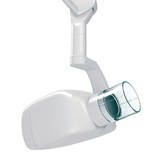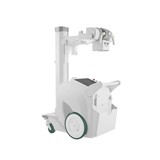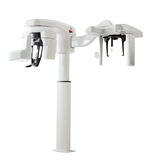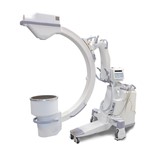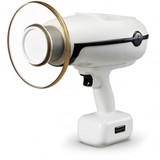X-ray machines are indispensable tools in modern medical diagnostics, demanding meticulous maintenance. This guide delves into the technical and safety aspects of proper maintenance and care for X-ray machines. By following these practices, healthcare facilities can ensure accurate diagnoses, extend the equipment's lifespan, and uphold patient and staff safety.
I. Regular Cleaning and Disinfection Protocols
A. Importance of Cleanliness in Preventing Contamination and Ensuring Accurate Results
- Cleanliness is not merely a superficial consideration; it is an integral aspect of X-ray machine functionality.
- Contaminants on detectors and surfaces can distort imaging results, impacting diagnostic accuracy.
- The correlation between a clean machine and precise diagnoses underscores the necessity of rigorous cleaning protocols.
B. Step-by-Step Cleaning Process for Various Components (Detectors, Panels, Surfaces)
- Begin by powering off the machine and disconnecting it from the power source to ensure safety.
- Use lint-free, non-abrasive cloths and approved cleaning solutions to wipe down surfaces.
- Pay meticulous attention to detector surfaces, which directly influence image quality.
- Clean control panels and buttons with care to prevent debris accumulation that might hinder functionality.
C. Recommended Disinfectants and Materials That Do Not Damage Sensitive Parts
- Opt for disinfectants approved by the machine's manufacturer to safeguard against damage.
- Avoid abrasive materials that might scratch surfaces or compromise the integrity of detectors.
- Ensure that disinfectants do not leave residues that could affect imaging quality.
- Regularly review and update the list of approved cleaning materials to align with best practices.


Find the right X-Ray Machine
Compare quotes from expert Australian suppliers and make the best choice. It's free, quick and easy!
II. Scheduled Preventive Maintenance for Optimal Performance
A. Explanation of the Concept of Preventive Maintenance
Preventive maintenance involves a systematic approach to maintaining an X-ray machine in order to prevent unexpected breakdowns and ensure its consistent performance. Instead of waiting for a component to fail, preventive maintenance focuses on regular checks and tasks to identify and address potential issues before they escalate. This approach contributes to the overall longevity and reliability of the machine.
B. Benefits of Adhering to a Regular Maintenance Schedule
Adhering to a well-structured maintenance schedule offers several key advantages for X-ray machines and the healthcare facility as a whole:
- Enhanced Reliability: Regular maintenance minimizes the risk of sudden malfunctions, reducing downtime and potential disruptions to patient care.
- Optimized Performance: Well-maintained machines consistently deliver accurate results, contributing to precise diagnostics and better patient outcomes.
- Cost Savings: Addressing minor issues during preventive maintenance helps avoid major repairs, which can be significantly more expensive.
- Extended Lifespan: By proactively addressing wear and tear, X-ray machines can operate efficiently for a longer duration.
- Compliance and Safety: Routine maintenance ensures that the machine complies with safety standards and regulations, safeguarding both patients and staff.
C. Detailed Checklist for Preventive Maintenance Tasks
Efficient preventive maintenance requires a comprehensive checklist that covers various aspects of the X-ray machine. Key tasks include:
- Inspection of Mechanical Parts:
- Examination of moving components (e.g., gantry, positioning mechanisms) for signs of wear, misalignment, or unusual noise.
- Tightening or adjustment of any loose or improperly fastened parts.
- Assessment of Electrical Connections:
- Thorough inspection of wiring and connections to identify loose or frayed wires.
- Verification that all electrical components are properly grounded to prevent electrical hazards.
- Verification of Software Updates:
- Check for the latest software updates provided by the manufacturer.
- Installation of updates to ensure the machine operates with the latest features, security enhancements, and bug fixes.
- Lubrication of Moving Parts:
- Application of appropriate lubricants to mechanical components to reduce friction and wear.
- Adherence to manufacturer-recommended lubrication intervals and types
III. Calibration and Alignment of X-Ray Tube and Detectors
Accurate calibration and precise alignment of X-ray tubes and detectors are integral aspects of maintaining the optimal performance and diagnostic accuracy of X-ray machines. Calibration ensures that the machine produces consistent and reliable images, while proper alignment helps minimize errors that could impact diagnoses. This section provides a detailed explanation of the calibration process and the significance of detector alignment.
A. Significance of Accurate Calibration and Alignment
Calibration and alignment are fundamental to the functionality of X-ray machines. The accuracy of diagnostic information heavily relies on the consistent performance of the equipment. Accurate calibration ensures that the X-ray machine produces images with correct measurements of density and attenuation, which are essential for accurate diagnoses. Proper alignment, on the other hand, ensures that the X-ray beam is focused precisely on the detector, minimizing image distortions and artifacts that could lead to misinterpretations.
B. Role of Calibration in Maintaining Diagnostic Accuracy
Calibration directly influences the accuracy of the X-ray images produced. Inconsistent calibration can result in variations in image quality and density measurements. This, in turn, can lead to misinterpretations by radiologists and medical professionals. Properly calibrated X-ray machines provide images that are consistent, reliable, and allow for more accurate diagnoses, ultimately improving patient care.
C. Explanation of the Calibration Process Step by Step
- Inspection of Mechanical Parts: Before calibration, a thorough inspection of the X-ray machine's mechanical components is necessary. This ensures that there are no physical obstructions or mechanical issues that could interfere with the calibration process.
- Assessment of Electrical Connections: The X-ray machine's electrical connections are checked to ensure that all components are properly connected and functioning. Any loose connections can disrupt the calibration process and lead to inaccuracies in image production.
- Verification of Software Updates: X-ray machines often have software components that require periodic updates. These updates may include improvements in calibration algorithms and image processing. Verifying and applying the latest software updates is crucial for maintaining optimal performance.
- Lubrication of Moving Parts: Moving parts within the X-ray machine, such as the gantry and tube positioning mechanisms, need to be well-lubricated. Proper lubrication ensures smooth movements during the calibration process and reduces wear and tear on components.
D. Importance of Detector Alignment for Minimizing Errors
Detector alignment plays a pivotal role in image accuracy. Misaligned detectors can lead to geometric distortions and inaccuracies in image measurements. By ensuring precise alignment, the X-ray machine produces images that faithfully represent the anatomical structures being examined, enabling more accurate diagnoses.
IV. Replacing Worn-Out Components and Spare Parts Sourcing
Proper maintenance of X-ray machines involves vigilant monitoring of the condition of various components. Over time, wear and deterioration can occur, affecting both the machine's performance and the accuracy of diagnostic results. Recognizing signs of wear and knowing when to replace components is essential for ensuring optimal functionality. Here are the key steps and considerations for identifying worn-out components and sourcing appropriate spare parts:
A. Identifying Signs of Wear and Deterioration in X-ray Machine Components
X-ray machines comprise intricate mechanical, electrical, and electronic parts, all of which can experience wear and tear due to constant usage. Signs of wear may include:
- Irregularities in image quality, such as artifacts or inconsistencies
- Unusual noises during operation, signaling mechanical stress
- Changes in exposure settings not reflected in the images
- Malfunctions or errors indicated on the machine's display
- Inconsistent performance over consecutive scans
B. List of Essential Components that Might Require Replacement Over Time
Certain components in X-ray machines are more susceptible to wear due to their continuous use and exposure to radiation. These components may include:
- X-ray tube: The heart of the machine, responsible for emitting radiation. Over time, the tube's efficiency can decrease.
- Detectors: These capture X-ray signals and contribute to image quality. Deterioration can lead to distorted or inaccurate images.
- Filters and collimators: These devices help control radiation output. Gradual degradation can impact image accuracy.
- Cables and connectors: Continuous movement and radiation exposure can weaken these elements, affecting signal transmission.
- Cooling systems: Efficient cooling is crucial to prevent overheating and maintain consistent performance.
C. Tips for Sourcing Genuine and Compatible Spare Parts
When it comes to replacing components, using genuine and compatible spare parts is essential to maintain the machine's performance and adhere to safety standards. Consider the following tips:
- Authorized suppliers: Purchase spare parts from authorized dealers or suppliers recommended by the manufacturer.
- Serial and model numbers: Provide accurate machine details to suppliers to ensure compatibility of spare parts.
- Quality assurance: Look for suppliers who offer warranties on their products, ensuring their quality and durability.
- OEM vs. aftermarket parts: While aftermarket parts might be cheaper, they may not always meet the same quality standards as original equipment manufacturer (OEM) parts.
- Documentation: Keep records of replaced parts, including their serial numbers, installation dates, and supplier information.
D. Caution Against Using Unauthorized Parts and Potential Risks
Using unauthorized or counterfeit spare parts can lead to serious risks, including:
- Compromised image quality: Non-genuine parts might not perform as expected, resulting in subpar diagnostic images.
- Safety hazards: Poorly manufactured parts could lead to malfunctions, potentially endangering patients and operators.
- Warranty issues: Using unauthorized parts can void the machine's warranty and result in expensive repairs.
- Regulatory non-compliance: Medical equipment must meet strict regulatory standards. Non-compliant parts could lead to legal issues.
By meticulously inspecting components, sourcing quality spare parts, and adhering to manufacturer recommendations, you can significantly extend the lifespan of your X-ray machine while ensuring accurate and reliable diagnostic outcomes.


Find the right X-Ray Machine
Compare quotes from expert Australian suppliers and make the best choice. It's free, quick and easy!
V. Training Staff on Safe Handling and Maintenance Procedures
A. Highlighting the Link Between Proper Training and Equipment Longevity
Proper training plays a crucial role in extending the lifespan of X-ray machines.
Well-trained staff are more likely to identify and address issues promptly, preventing further damage.
B. Creating a Comprehensive Training Program for Staff Members
Develop a structured training program tailored to the specific needs of your facility.
The involvement of experienced technicians and manufacturers can enhance the program's effectiveness.
C. Topics to Cover in Training:
- Safe Handling Practices:
- Emphasize adherence to safety protocols during operation and maintenance.
- Demonstrate correct techniques for minimizing exposure risks to both patients and staff.
- Basic Troubleshooting:
- Equip staff with foundational troubleshooting skills to identify common issues.
- Teach them how to diagnose simple problems that may affect performance.
- Reporting Maintenance Issues Promptly:
- Stress the importance of timely reporting of any abnormalities or malfunctions. Establish clear communication channels for reporting to the maintenance team.
- Regulations encompass areas such as equipment performance, radiation safety, and operational standards.
In conclusion, the proper maintenance and care of X-ray machines are essential for the accuracy of medical diagnostics, the safety of patients and staff, and the longevity of the equipment. This guide has highlighted key aspects of maintaining X-ray machines, including regular cleaning and disinfection protocols, scheduled preventive maintenance, calibration, alignment, and the replacement of worn-out components with genuine spare parts. Moreover, it emphasizes the critical role of staff training in ensuring safe handling and effective maintenance procedures. By following these guidelines diligently, healthcare facilities can not only enhance the reliability and performance of their X-ray machines but also contribute to better patient care and compliance with regulatory standards.







